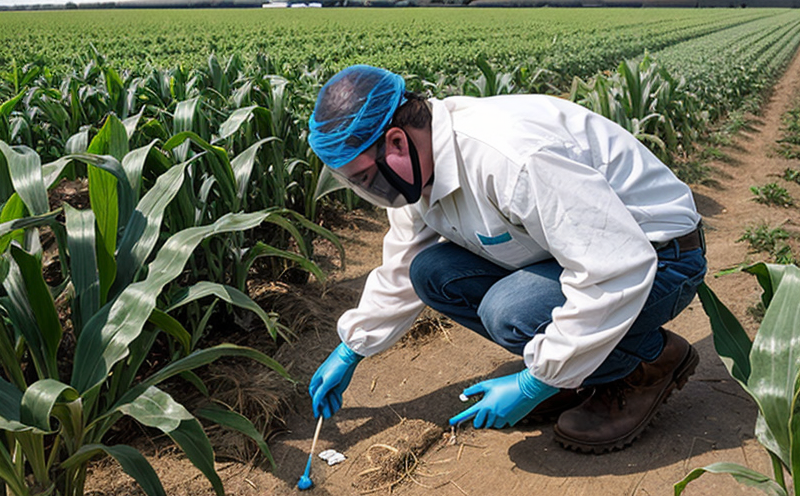Aldrin Residue Testing in Crops
In the realm of agriculture and forestry testing, pesticide residue analysis plays a crucial role in ensuring food safety and environmental protection. Aldrin is a synthetic organochlorine insecticide that has been widely used for pest control in crops such as cotton, rice, and wheat. However, its use has been restricted or banned due to health concerns and environmental impacts. Testing for Aldrin residue in crops is essential for compliance with international regulations and standards.
The presence of Aldrin residues in food can pose serious health risks, including neurotoxicity, carcinogenic effects, and hormonal disruption. Therefore, accurate and reliable testing methods are vital to monitor the levels of Aldrin in agricultural produce before it reaches consumers. The testing process involves several key steps: sample collection, extraction, cleanup, analysis, and reporting.
Sample collection typically follows strict protocols established by international standards such as ISO 3696 and ASTM E1253. These guidelines ensure that the samples are representative of the entire batch or lot being tested. Extraction methods may vary depending on the type of crop and the expected residue levels, but common techniques include liquid-liquid extraction (LLE) using solvents like dichloromethane.
Cleanup steps often involve solid-phase extraction (SPE), which helps remove matrix interferences from the sample. After cleanup, the extract is concentrated or diluted as necessary and then ready for analysis by gas chromatography with mass spectrometry (GC-MS). GC-MS provides high sensitivity and selectivity, making it suitable for detecting trace amounts of Aldrin even at parts per billion levels.
Once the analytical results are obtained, they must be interpreted against relevant regulatory limits set forth by authorities like the European Union (EU) or United States Environmental Protection Agency (EPA). Compliance with these regulations is critical to avoid legal penalties and maintain consumer trust. Additionally, testing results contribute valuable data for ongoing research on pesticide efficacy and environmental impact.
Accurate Aldrin residue testing supports sustainable agricultural practices by providing actionable insights into crop management strategies. For instance, if high levels of Aldrin are detected in a particular field, farmers can adjust their spraying schedules or switch to alternative pesticides that pose fewer risks. This not only enhances food safety but also promotes biodiversity and reduces pollution.
- Reduces contamination risk for consumers
- Promotes safer agricultural practices
- Supports regulatory compliance
- Enhances environmental stewardship
In conclusion, Aldrin residue testing in crops is an indispensable service that ensures public health and supports sustainable farming. By adhering to rigorous analytical techniques and international standards, laboratories can deliver accurate results that inform decision-making processes at various stages of the agricultural supply chain.
Why It Matters
The presence of Aldrin residues in crops is a significant concern due to its toxicological profile. As mentioned earlier, Aldrin belongs to the organochlorine class of pesticides which are known for their persistence and bioaccumulation potential. When ingested by humans or animals, it can lead to serious health issues including neurological disorders, reproductive problems, and increased cancer risk.
Given its long half-life and ability to accumulate in fatty tissues, Aldrin poses a particular threat to ecosystems where it might persist for decades after application. This persistent nature makes it particularly challenging to manage through conventional cleanup methods alone. Therefore, regular monitoring of Aldrin residues becomes crucial not only from a human health perspective but also from an environmental standpoint.
From an economic viewpoint, non-compliance with regulatory requirements could result in hefty fines and damage to brand reputation. Companies involved in pesticide manufacturing or distribution must ensure that their products meet stringent quality standards before being introduced into markets worldwide. Similarly, importers need reliable data on residual levels to protect their supply chains from contaminated goods.
In summary, Aldrin residue testing is vital because it helps safeguard human health and the environment while fostering responsible business practices among stakeholders across the agricultural sector. It serves as both a preventive measure against potential risks associated with this pesticide and an essential tool for maintaining regulatory integrity within global trade networks.
Scope and Methodology
The scope of Aldrin residue testing encompasses the identification, quantification, and qualification of Aldrin residues in various types of crops intended for human consumption. This service is designed to meet stringent regulatory requirements set by organizations such as the World Health Organization (WHO), Food and Agriculture Organization (FAO), and national food safety agencies.
The methodology employed involves a series of carefully orchestrated steps aimed at ensuring accurate and reliable results. Initially, samples are collected from fields or storage facilities according to prescribed sampling protocols. These samples represent different parts of the crop plant, including leaves, stems, fruits, seeds, etc., depending on where Aldrin might be expected to accumulate.
Following collection, samples undergo extensive preparation which includes cleaning and concentrating the extracts using advanced techniques such as solid-phase extraction (SPE) or liquid-liquid extraction (LLE). This step removes unwanted components that could interfere with subsequent analytical processes. Once prepared, the samples are analyzed via gas chromatography coupled with mass spectrometry (GC-MS), an instrument capable of detecting extremely low concentrations.
The GC-MS system operates under specific operating conditions tailored to maximize detection sensitivity and specificity for Aldrin compounds. Chromatograms generated from these analyses provide detailed information regarding the amount and distribution of Aldrin within each sample. Based on these findings, compliance with established limits is determined based on relevant international standards like ISO 3696 or EU Maximum Residue Limits (MRLs).
Finally, comprehensive reports summarizing all aspects of the testing procedure are delivered to clients along with detailed interpretations highlighting any deviations from acceptable levels. These reports serve as valuable resources for stakeholders involved in crop production and processing industries who rely on this information to make informed decisions about product quality assurance.





